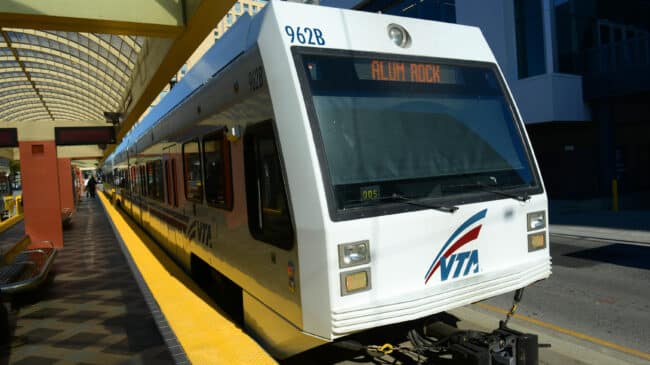Many Bay Area residents are deeply concerned about climate change and actively support local transit projects to reduce greenhouse gas emissions. But building more mass transit infrastructure locally often fails to move the needle very much. Rather than build expensive new transit infrastructure, Bay Area innovators should be applying technologies to make off-peak transit on existing lines and working from home more convenient.
Well before the COVID-19 pandemic, the Bay Area’s mass transit ridership was declining. This means that the costly transit projects now in the works or on the drawing board are likely to have a much smaller effect on the climate than previously expected.
A Santa Clara Civil Grand Jury report found, “[The Santa Clara Valley Transportation Authority] VTA’s light rail system is one of the most expensive, heavily subsidized and least used light rail systems in the country.”
Yet the Valley Transportation Authority is continuing to move forward with a $468 million, 2.4-mile light rail extension from Eastridge to Milpitas. With an average weekday ridership of less than 10,000 prior to the suspension of service, the more appropriate question is whether LRT service should be reduced rather than extended.
Similarly, the recently opened BART extension to Milpitas and Berryessa cost $2.3 billion, but, as the pandemic continues, the two new stations each are currently serving only around 400 exiting passengers daily. Extending service to downtown San Jose and Santa Clara is expected to cost $6.9 billion and take until 2030, while the estimate of 52,000 daily riders, made before the pandemic, seems unlikely to materialize.
Meanwhile, San Francisco is spending $1.6 billion on its repeatedly delayed Central Subway and $346 million for a two-mile Bus Rapid Transit line on Van Ness Avenue, which is now three years behind schedule. Collectively, these projects will put no more than a tiny dent into the 940,000 private automobile trips that occur in the city of San Francisco on an average weekday.
Spending billions of dollars to replace a relatively small number of car trips is not a cost-effective approach to combating climate change, but the Bay Area has other powerful tools in its shed. High-speed internet, cloud computing, online meeting tools and project collaboration software are reducing the need for many professionals to drive to offices or fly to conferences.
Bay Area companies have contributed to these innovations and are taking the lead in reconceptualizing the workplace to support hybrid or fully remote work. And these new technologies can be implemented around the world, reducing the need for commuting and in-person meetings globally.
We can replace millions of car trips by making it cheaper and easier for employees to collaborate with colleagues from home or from co-working spaces within walking distance from home. This means making technology improvements such as higher transmission speeds, increased network reliability and better software tools for collaboration.
Transit innovations could also contribute. If transit agencies could implement driverless buses and trains, they could affordably maintain five-minute headways throughout the day rather than just at peak rush hours. As more employees return to their offices, they could begin coming in on a staggered basis without having to worry about long waits on the platform.
To the extent that Bay Area innovators can leverage autonomous vehicle technologies to implement driverless transit at low cost, they can benefit not only VTA, BART and SF Muni, but other transit systems around the country and the world.
With only 0.1 percent of the world’s population, there is only so much the Bay Area can contribute to climate change alleviation through local mass transit initiatives. Rather than build expensive new transit infrastructure, the Bay Area should find more cost-effective solutions.
A version of the column previously appeared in the Mercury News.

